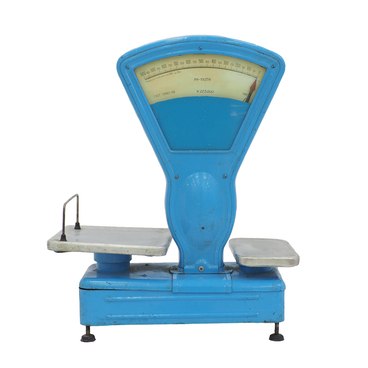The mechanical manual calculator, which is housed in the museum, was used to count the relative number of different types of leukocytes in the blood. The mechanism is carefully protected by the black rectangular metal case. On one side is a round toothed handle. Its diameter is four cm.
On the top part of the case, there is a horizontal glass panel with special holes showing the rows of numbers. There is a mechanism with rotating rollers and axles under the sidewalls of the case. Each roller has its drum containing the row of numbers from zero to nine. At the bottom of the calculator, under the glass panel, there are eight main levers with cylinder hands. They have round keys: ‘M’, ‘Ю’, ‘П’, ‘С’, ‘E’, ‘MOН’, ‘Б’, ‘Л’ on their ends. Each lever is connected with a corresponding roller. In the left lower part there are also three reserve levers with numbers ‘one’, ‘two’, and ‘three’.
The medical specialist looked through a microscope and counted the number of leukocytes of each type: neutrophils, eosinophils, monocytes, basophils, and others. Then he sequentially typed them on the counter keys. Each time the keys were pressed, the cylinder spun one unit. In other words, pressing the key once was equal to one cell. As a result, the total number of leukocytes based on all the data appeared in the far-right window of the glass screen. To reset the values, it was necessary to turn the side handle.
The medical laboratory service appeared in Seversk in the 1950s. The first clinical research started in 1953 in the polyclinic on Gorky Street. At that time, only two people were working in the laboratory: doctor Marina Melnikova and a laboratory assistant Alexandra Karbysheva.
Research works and admission of patients were carried out in a cramped small room equipped as a laboratory. In 1954, the bacteriological laboratory was separated from the polyclinic and moved into two apartments specially modified for this purpose. They are located at 22 Pervomayskaya Street. Tamara Anisimova headed the laboratory. A serological laboratory department under doctor Maria Zelenova’s leadership appeared in the same year. A biochemical department under Doctor Alla Kuznetsova’s leadership appeared in 1958.
On the top part of the case, there is a horizontal glass panel with special holes showing the rows of numbers. There is a mechanism with rotating rollers and axles under the sidewalls of the case. Each roller has its drum containing the row of numbers from zero to nine. At the bottom of the calculator, under the glass panel, there are eight main levers with cylinder hands. They have round keys: ‘M’, ‘Ю’, ‘П’, ‘С’, ‘E’, ‘MOН’, ‘Б’, ‘Л’ on their ends. Each lever is connected with a corresponding roller. In the left lower part there are also three reserve levers with numbers ‘one’, ‘two’, and ‘three’.
The medical specialist looked through a microscope and counted the number of leukocytes of each type: neutrophils, eosinophils, monocytes, basophils, and others. Then he sequentially typed them on the counter keys. Each time the keys were pressed, the cylinder spun one unit. In other words, pressing the key once was equal to one cell. As a result, the total number of leukocytes based on all the data appeared in the far-right window of the glass screen. To reset the values, it was necessary to turn the side handle.
The medical laboratory service appeared in Seversk in the 1950s. The first clinical research started in 1953 in the polyclinic on Gorky Street. At that time, only two people were working in the laboratory: doctor Marina Melnikova and a laboratory assistant Alexandra Karbysheva.
Research works and admission of patients were carried out in a cramped small room equipped as a laboratory. In 1954, the bacteriological laboratory was separated from the polyclinic and moved into two apartments specially modified for this purpose. They are located at 22 Pervomayskaya Street. Tamara Anisimova headed the laboratory. A serological laboratory department under doctor Maria Zelenova’s leadership appeared in the same year. A biochemical department under Doctor Alla Kuznetsova’s leadership appeared in 1958.

